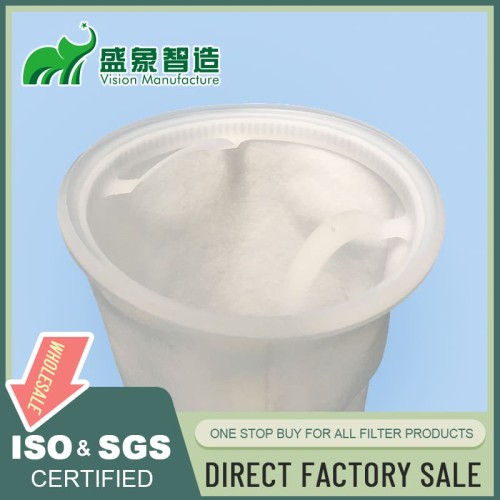
50 Micron Filter Bags Strike the Balance in Precision Industrial Filtration
I. Introduction
In the world of industrial filtration, the precision of the filtration process is paramount, and micron ratings play a crucial role in determining the suitability of a filter for specific applications. This introduction explores the significance of 50 micron filter bags, highlighting their role in various industrial filtration processes and their impact on achieving desired cleanliness and efficiency.
II. Understanding 50 Micron Filtration
A 50 micron filter bag is designed to capture particles that are 50 micrometers in diameter, offering a balance between fine and coarse filtration. This section will delve into what exactly a 50 micron rating means, providing a perspective on particle size and discussing the efficiency of filtration at this micron level.
III. Types of 50 Micron Filter Bags
50 micron filter bags come in various materials, constructions, and sizes to suit different industrial needs:
- Material Options: Include polypropylene, polyester, nylon, and more, each offering unique benefits.
- Construction Methods: Such as sewn or welded, which affect the durability and efficiency of the bags.
- Size and Shape Variations: Tailored to fit different systems and applications.
- Vision Filter's Range: Showcasing a variety of 50 micron filter bags designed to meet diverse operational requirements.
IV. Applications of 50 Micron Filter Bags
These filter bags are utilized in numerous sectors due to their versatility:
- Water and Wastewater Treatment: Essential for removing particulates from water.
- Chemical Processing: Used in the filtration of chemicals to ensure purity and prevent contamination.
- Food and Beverage Industry: Critical in maintaining the clarity and quality of products.
- Automotive Fluids: Helps in filtering oils and other fluids in automotive applications.
- Paint and Coatings: Ensures smooth finishes by filtering out impurities.
- Other Industrial Uses: Applied in various other sectors where precise filtration is necessary.
V. Advantages of 50 Micron Filter Bags
The benefits of using 50 micron filter bags include:
- Balanced Filtration Efficiency: Effective in removing a broad range of particulates without overly restricting flow.
- High Flow Rates: Allows for high volumes of fluid to be processed efficiently.
- Extended Service Life: Durable materials and construction extend the lifespan of the bags.
- Cost-effectiveness: Offers a good balance between performance and expense.
- Versatility Across Industries: Suitable for a wide range of applications due to their adaptable design.
VI. Choosing the Right 50 Micron Filter Bag
Selecting the appropriate filter bag involves several considerations:
- Material Compatibility: Ensuring the material is suitable for the specific chemicals and temperatures of the application.
- Flow Rate: Matching the bag’s capabilities with the system’s flow requirements.
- Contaminant Type: Understanding the nature of the particulates being filtered.
- Retention Ratings: Deciding between nominal and absolute ratings based on required purity levels.
- Vision Filter's Approach: Utilizing expert knowledge to assist in selecting the optimal filter bag.
VII. Installation and Maintenance
Proper installation and maintenance are crucial for maximizing the performance of 50 micron filter bags:
- Installation Techniques: Ensuring correct fitting to prevent bypass and ensure efficiency.
- Monitoring and Replacement Guidelines: Regular checks to determine when replacements are needed.
- Cleaning and Reuse Considerations: Guidelines for cleaning the bags to extend their use where applicable.
- Troubleshooting Common Issues: Addressing typical problems that may arise during operation.
VIII. Comparing 50 Micron to Other Micron Ratings
Understanding when to use 50 micron filtration versus other ratings involves:
- Comparison with Finer Filtration: Such as 10 or 25 microns, which may be necessary for more critical applications.
- Comparison with Coarser Filtration: Such as 100 or 200 microns, which is suitable for less stringent conditions.
- Cost and Performance Comparisons: Evaluating the trade-offs between finer filters and their cost implications.
IX. Environmental and Sustainability Aspects
The sustainability of using 50 micron filter bags is considered through:
- Recyclability of Materials: Encouraging the use of recyclable materials to reduce environmental impact.
- Energy Efficiency in Filtration Processes: Optimizing operations to consume less energy.
- Waste Reduction Strategies: Minimizing waste through efficient filtration and reusable materials.
- Vision Filter's Commitment: Focusing on sustainable practices in product development and operations.
X. Innovations in 50 Micron Filter Bag Technology
Advancements in filter bag technology include:
- Advanced Materials: For improved performance and durability.
- Multi-layer Designs: Enhancing filtration efficiency without compromising flow rate.
- Integration with IoT: For smart monitoring and predictive maintenance capabilities.
- Vision Filter's Contributions: Leading the industry with innovative solutions that enhance filtration efficiency and sustainability.
XI. Case Studies: 50 Micron Filter Bags in Action
Real-world applications demonstrate the effectiveness of 50 micron filter bags in various industries, showcasing their ability to solve complex filtration challenges and deliver significant improvements in performance and operational efficiency.
XII. Future Trends in Precision Filtration
The future of precision filtration with 50 micron bags looks promising, with potential advancements in material technology and integration with smart systems enhancing their applicability and efficiency.
XIII. Conclusion
50 micron filter bags play a crucial role in balancing efficiency and flow in industrial filtration, providing a versatile solution that meets a wide range of industrial needs. As the demand for precise and efficient filtration continues to grow, Vision Filter remains dedicated to providing cutting-edge solutions and expert consultation to help industries achieve optimal filtration performance.
Leave a comment

